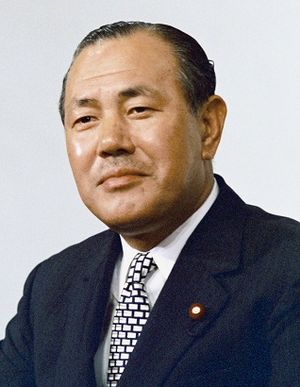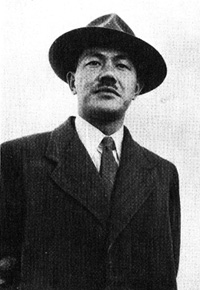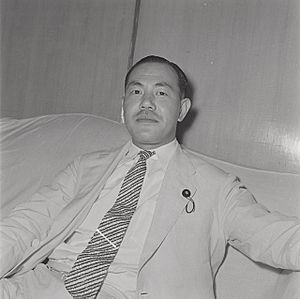Kakuei Tanaka facts for kids
Quick facts for kids
Kakuei Tanaka
|
|||||
|---|---|---|---|---|---|
|
田中 角栄
|
|||||
 |
|||||
| Prime Minister of Japan | |||||
| In office 7 July 1972 – 9 December 1974 |
|||||
| Monarch | Shōwa | ||||
| Deputy | Takeo Miki | ||||
| Preceded by | Eisaku Satō | ||||
| Succeeded by | Takeo Miki | ||||
| Minister of International Trade and Industry | |||||
| In office 5 July 1971 – 7 July 1972 |
|||||
| Prime Minister | Eisaku Satō | ||||
| Preceded by | Kiichi Miyazawa | ||||
| Succeeded by | Yasuhiro Nakasone | ||||
| Minister of Finance | |||||
| In office 18 July 1962 – 3 June 1965 |
|||||
| Prime Minister | Hayato Ikeda Eisaku Satō |
||||
| Preceded by | Mikio Mizuta | ||||
| Succeeded by | Takeo Fukuda | ||||
| Minister of Posts and Telecommunications | |||||
| In office 10 July 1957 – 12 June 1958 |
|||||
| Prime Minister | Nobusuke Kishi | ||||
| Preceded by | Taro Hirai | ||||
| Succeeded by | Yutaka Terao | ||||
| Member of the House of Representatives | |||||
| In office 25 April 1947 – 18 February 1990 |
|||||
| Constituency | Niigata 3rd | ||||
| Personal details | |||||
| Born | 4 May 1918 Nishiyama, Empire of Japan |
||||
| Died | 16 December 1993 (aged 75) Tokyo, Japan |
||||
| Political party | Liberal Democratic Party (1955–1993) | ||||
| Other political affiliations |
Democratic Party (1947–1950) Democratic Liberal Party (1950–1955) |
||||
| Spouse | Hana Sakamoto | ||||
| Children | Masanori Tanaka (by Hana Sakamoto, died age 4) Makiko Tanaka (by Hana Sakamoto) Kyo Tanaka (by Tsuji Wako) Hitoshi Tanaka (by Tsuji Wako) Atsuko Sato (by Akiko Sato) |
||||
| Signature |  |
||||
| Military career | |||||
| Allegiance | |||||
| Service/ |
|||||
| Years of service | 1939–1941 | ||||
| Rank | Superior Private | ||||
| Battles/wars | Second Sino-Japanese War Second World War |
||||
| Japanese name | |||||
| Shinjitai | 田中 角栄 | ||||
| Kyūjitai | 田中 角榮 | ||||
| Kana | たなか かくえい | ||||
|
|||||
Kakuei Tanaka (田中 角栄 or 田中 角榮, Tanaka Kakuei, 4 May 1918 – 16 December 1993) was a Japanese politician. He was a member of the House of Representatives from 1947 to 1990. He also served as Prime Minister of Japan from 1972 to 1974.
Tanaka became a very powerful figure in Japan's ruling Liberal Democratic Party (LDP). This was from the mid-1960s until the mid-1980s. He was involved in some political problems, including the Lockheed bribery scandals in 1976. These accusations led to his arrest. He was found responsible by two courts, but his case was still being reviewed when he passed away. After facing these issues and having health problems in 1985, his political group lost its strength. Many members later joined a new group led by Noboru Takeshita.
People called him Kaku-san or the "Shadow Shōgun" (Yami-shōgun). This nickname meant he had a lot of hidden power. His focus on building new things in Japan was called the "construction state" (Doken Kokka). His daughter, Makiko Tanaka, and son-in-law, Naoki Tanaka, are still active in Japanese politics today.
Contents
Early Life and Education
Kakuei Tanaka was born on May 4, 1918, in Futamura, Niigata Prefecture. This area is now part of Kashiwazaki, Niigata. He was the second son of a farmer, Kakuji Tanaka, and his wife Fume. He had seven brothers and sisters, but he was the only son who lived to be an adult.
His family faced financial difficulties when he was young. His father tried different businesses, like farming fish and importing cows, which did not go well. Kakuei also had diphtheria as a child, which caused him to stutter. He left school at age fifteen and worked in construction. At the same time, he studied at night.
In 1937, Tanaka met Masatoshi Ōkōchi, the head of the Riken company. Ōkōchi was impressed by Tanaka's energy. He helped Tanaka start a drafting office in Tokyo. Tanaka later helped create the system for licensing architects in Japan.
In 1939, Tanaka joined the army and went to Manchuria. He worked as a clerk and reached the rank of superior private. In 1941, he got pneumonia and returned to Tokyo. He left the army that October. Back in Japan, he met the widow of the Sakamoto Civil Engineering firm's president. She helped him restart his drafting business. She also asked him to marry her daughter, Sakamoto Hana. Tanaka agreed, marrying into a well-known family.
Rise in Japanese Politics
In 1942, Tanaka took over the Sakamoto company. He renamed it Tanaka Civil Engineering and Construction Industries. He had two children: a son, Masanori, born in 1942 (who passed away in 1948), and a daughter, Makiko Tanaka, born in 1944.
During World War II, Tanaka was lucky. None of his main buildings were damaged during the firebombing of Tokyo. Just before Japan surrendered, he went to Seoul. There, he cashed in a large amount of Japanese war bonds. In 1945, he gave money to a political group called the Japan Moderate Progressive Party.
In 1946, he moved to Niigata to try and win a seat in the Diet. He put up large "TANAKA" signs on buildings he bought. However, he only got 4% of the votes in that election.
In 1947, he tried again and won a seat. He became a member of the new Democratic Party. In the Diet, he became friends with former prime minister Kijūrō Shidehara. He joined Shidehara's Doshi Club. In 1948, the Doshi Club joined the new Democratic Liberal Party. Tanaka quickly gained favor with the party's leader, Shigeru Yoshida. Yoshida made Tanaka a Vice Minister of Justice, making him the youngest in Japan's history.
However, in December 1948, Tanaka was arrested. He was accused of taking money from coal mining companies. Yoshida and the party distanced themselves from him. They refused to help fund his next election campaign. Despite this, Tanaka ran again in 1949. He was released from prison after getting bail. He won re-election. He then made a deal to keep his party membership.
In 1950, a court found Tanaka responsible for the accusations. He appealed the decision. Meanwhile, he took over the struggling Nagaoka Railway. He managed to bring it back to life by 1951. In that year's election, he won by a large margin. Many of the railroad's employees campaigned for him. This election was also the first time he was supported by the wealthy businessman Kenji Osano. Osano remained a loyal supporter of Tanaka.
Etsuzankai Support Group
Tanaka's most important support group was called Etsuzankai. This name means "Niigata Mountain Association." Etsuzankai helped Tanaka by collecting requests from villagers in Niigata. Tanaka would then use government money for projects to help these areas. These projects were often called "pork barrel" projects.
In return, the villagers financially supported Etsuzankai. This group then funded the election campaigns of local Diet members, including Tanaka. At its peak, Etsuzankai had 100,000 members.
Some projects funded by Etsuzankai included the Tadami River hydroelectric power project. They also funded the New Shimizu Tunnel and the Jōetsu Shinkansen high-speed rail line.
In the 1950s, Tanaka brought Etsuzankai members to his home in Tokyo by bus. He met with each person individually. He also gave them tours of the Diet and the Imperial Palace. This made Etsuzankai a very strong political group in Japan.
Becoming a Powerful Leader
Tanaka joined the Liberal Democratic Party (LDP) in 1955. This happened when the LDP absorbed his previous party.
When Nobusuke Kishi became prime minister in 1957, Tanaka got his first cabinet job. He became Minister of Posts and Telecommunications. In this role, he gave out the first television broadcasting licenses in Japan.
He had a lot of influence in the LDP, even though he was not the oldest member. This was partly because he was friends with future prime minister Eisaku Satō. Also, his stepdaughter married the nephew of future prime minister Hayato Ikeda. This gave him personal connections with important party leaders.
Under Ikeda's government, Tanaka became chairman of the Policy Affairs Research Council. He later became Minister of Finance. During his time as finance minister, Japan's economy grew very quickly. When Satō became prime minister in 1965, Tanaka was expected to become the LDP's new secretary general. However, a problem called the "Black Mist Scandal" came up. Tanaka was accused of questionable land deals in Tokyo. Because of this, Takeo Fukuda got the job instead.
Fukuda and Tanaka soon became rivals to take over from Satō. Their competition was called the "Kaku-Fuku War" by the Japanese press. Despite the scandal, Tanaka did very well in the 1967 election. Satō then made him secretary general, and Fukuda became finance minister. In 1971, Satō gave Tanaka another important role: minister of international trade and industry (MITI).
As head of MITI, Tanaka gained public support. He stood up to U.S. officials who wanted Japan to limit its exports. He had many contacts with American diplomats. People said he played a bigger role in getting Okinawa back to Japan than Satō did.
In June 1971, he published a book called "Theory of Remodeling the Japanese Islands." In this book, he promised to spread economic activities beyond Tokyo. The book sold 910,000 copies. It became a bestseller, especially after he became prime minister.
Prime Minister of Japan
Even though Satō wanted Fukuda to be the next prime minister, Tanaka was very popular. With support from other political groups, he won the LDP's party president election in 1971. He beat Fukuda with 282 votes to 190. He became prime minister with the highest popularity rating for a new leader in Japan's history.
Foreign Relations
One of Tanaka's most important achievements was making relations normal between Japan and the People's Republic of China. This happened around the same time Richard Nixon was working to improve U.S. relations with China. In 1972, Tanaka met with Chinese premier Zhou Enlai. They talked about making relations between the two countries normal. They also discussed the Senkaku Islands, which later became a point of disagreement. Just two months after becoming prime minister, Tanaka met Chinese Communist Party chairman Mao Zedong.
From 1973 to 1974, Tanaka visited many countries. These included the United States, France, Britain, West Germany, Italy, the Soviet Union, and several Southeast Asian nations. He appeared on the U.S. TV show Meet the Press in 1973. His visit to Europe was the first by a Japanese prime minister since 1962. His visit to the USSR was the first since 1956.
His visit to Indonesia in January 1974 led to protests. People were upset about foreign investment. Japanese goods and buildings were damaged. Eleven people died, 300 were hurt, and 775 protesters were arrested. This event became known as the Malari Incident.
Economic Plans
When he became prime minister in 1972, Tanaka announced a big plan for Japan's infrastructure. He wanted to build new expressways and high-speed rail lines across the country. This plan was based on his book, "Theory of Remodeling the Japanese Islands." He imagined moving more businesses to smaller cities. These cities would then be connected to major cities like Tokyo and Osaka by high-speed rail. This was a new idea at a time when only one Shinkansen line existed.
Tanaka's government also improved social welfare. They doubled national pension benefits. They introduced free medical care for older people. In 1972, they started child allowances. In 1973, pensions were adjusted for inflation. The Pollution Health Damage Compensation Law was also passed in 1973. This law helped people who got sick from pollution in certain areas.
However, Japan's economy and Tanaka's popularity were badly affected. This was due to the 1973 oil crisis, which caused prices to rise sharply.
Resignation from Office
In October 1974, a popular magazine called Bungeishunjū published an article. It said that business people close to Tanaka had made money. They did this by buying land in remote areas just before public construction projects were announced nearby. While this suggested some wrongdoing, the actions described were not actually illegal at the time.
The article encouraged Tanaka's rivals in the LDP to start a public investigation. The Diet committee called Etsuzankai's treasurer, Aki Sato, as a witness. Tanaka announced his resignation on November 26, 1974. This was to protect Sato and because of the public pressure. The announcement was read by Noboru Takeshita.
Tanaka's political group supported Takeo Miki to become the next prime minister. Tanaka then became a regular Diet member again.
Later Life and Passing
While his legal case was still ongoing, Tanaka's health got worse. He announced he was leaving politics in October 1989. He was 71 years old. His son-in-law, Naoki Tanaka, made the announcement. This ended Tanaka's 42-year career in politics. The remaining members of his political group, now led by former Prime Minister Takeshita, were still very powerful in the LDP. In 1993, some members of his group left the LDP. They formed part of a new government.
Tanaka was later diagnosed with diabetes. He passed away from pneumonia on December 16, 1993, at Keio University Hospital. After his death, his home in Tokyo was surrounded by supporters and journalists.
Honors Received
Foreign Honors
Legacy and Influence
Tanaka's political group stayed strong within the Liberal Democratic Party even after he passed away. It split in 1992 after Noboru Takeshita faced problems. Tsutomu Hata and Ichiro Ozawa left the LDP to form a new party. Keizo Obuchi took over what was left of Tanaka's group. He supported Ryutaro Hashimoto becoming prime minister. Obuchi himself became prime minister from 1999 to 2000. After Obuchi's death, Hashimoto led the group until 2005. The group, known as Heisei Kenkyūkai, continued under new leaders. However, they raised less money than before. This was due to changes in election laws and Japan's economic slowdown. These changes made political groups less powerful.
Tanaka built his group by finding and supporting new politicians. This method was later used by other important politicians. Junichiro Koizumi recruited many new LDP members in 2005. They were called "Koizumi Children". Ichiro Ozawa did something similar for the Democratic Party of Japan in 2009. However, these new members were not as loyal as Tanaka's group.
Makiko Tanaka, Kakuei's daughter, was not part of Etsuzankai. She was elected to her father's old seat in Niigata in 1993. She became foreign minister in 2001. Because of her father's role in Sino-Japanese relations, she was popular in China. She spoke out against some actions by Japan and the United States that China did not like. She lost her seat in the 2012 election. By then, Etsuzankai had ended, with only a few older members left.
See also
 In Spanish: Kakuei Tanaka para niños
In Spanish: Kakuei Tanaka para niños
- I'm Sorry
Images for kids





